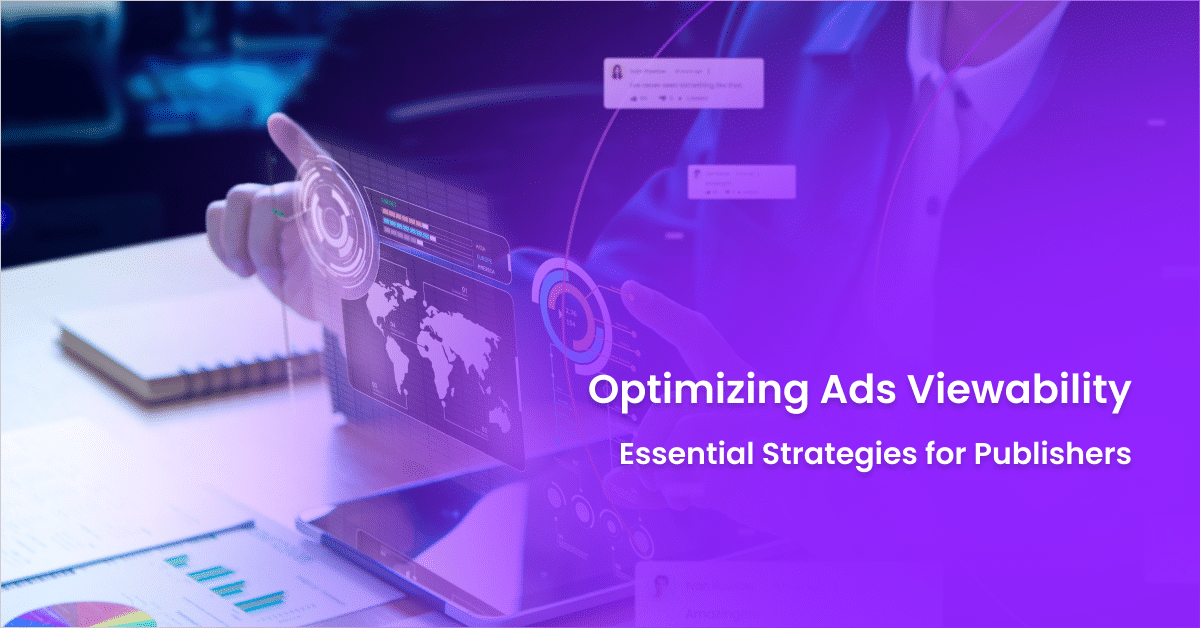Ad viewability is an important trend in the advertising industry, often regarded as the primary metric for valuing display and video ads.
So, why is ad viewability so important?
Both publishers and advertisers are striving to boost their ad viewability rates. In this article, you will learn what ad viewability is, why it is crucial for publishers and discover practical tips to optimize it.

What Is Viewability?
Viewability is a term that describes an online advertising metric that seeks to exclusively track impressions that users can see. For example, let’s say you have an ad placed on the bottom of a webpage. If a user doesn’t scroll down enough to see it, that impression won’t be deemed viewable.
So What Does “Viewed” Really Mean?
The standard definition of the Internet Advertising Bureau’s (IAB) and Media Rating Council’s (MRC) for viewability indicates that at least 50% of the ad must be in view for at least one second for display ads and two seconds for video ads.
Why Is Viewability Important?
As expected, advertisers want their ads seen by potential customers, but studies show that around 54% of ads aren’t viewed by users. In this sense, viewability is important for both advertisers and publishers, and it is designed to allow advertisers to pay only for the ads that users can see.
Just like other aspects of marketing, viewability is becoming more and more important as the industry is evolving. Viewability is a much more accurate metric to measure reach, avoiding any discrepancy in ads served versus ads viewed, giving publishers and advertisers more accurate insights and conclusions, and curating a more precise picture of how to drive better results.
In short, when ads are visible, advertisers get better returns on their investments, leading to:
– Building Trust: Advertisers trust publishers with high viewability rates.
– Higher Budgets: Advertisers are willing to increase budgets for viewable impressions.
– Long-Term Partnerships: Consistent viewability can lead to long-term relationships.
Factors Influencing Viewability Rates
Several factors can impact whether an ad is seen or not:
– Ad Placement: Ads placed “above the fold” (the visible part of the webpage without scrolling) have higher viewability rates.
– Page Load Speed: Faster-loading pages ensure that ads appear in time for users to see them.
– User Behavior: How users interact with your site (scroll speed, engagement levels) can affect whether they see the ads.
– Ad Size: Larger and vertical ad units tend to have higher viewability rates.
– Device Type: Mobile devices often have different viewability rates compared to desktops due to screen size and user behavior.
Now that you know what might be hurting your ad viewability score, let’s uncover some of the best practices to get the best results with your ad revenue strategy.
Enhancing Ad Viewability: 3 Key Elements to Watch
In this section, we will explore the key elements that influence ad viewability, why they are important, and how to optimize them for better performance and revenue.
Increasing Ad Inventory Value
Why is important?
- High viewability boosts ad inventory value. More visible ads mean better performance metrics, such as click-through rates (CTR) and conversion rates.
How to improve it?
- Higher CPMs: Advertisers pay more for high-performing ads.
- Increased Demand: More advertisers compete for high-viewability spots.
- Optimized Revenue: Better-performing ads lead to increased overall revenue.
Improving User Experience
Why is important?
- User experience (UX) directly affects viewability. Ads that load quickly and appear in non-intrusive locations keep users engaged without frustration. Poor UX can drive users away, reducing ad viewability and site visits.
How to improve it?
- Page Load Speed: Faster pages improve UX and ad viewability.
- Ad Placement: Strategically placed ads enhance the browsing experience.
- Responsive Design: Ensures ads look good on all devices.
Meeting Industry Standards
Why is important?
- Industry standards, like those set by the Interactive Advertising Bureau (IAB), define what makes an ad viewable. Meeting these standards is crucial for credibility and competitiveness.
How to improve it?
- Compliance: Adhering to standards ensures your site meets advertiser expectations.
- Competitive Edge: Sites that meet/exceed standards attract more business.
Understanding what constitutes a good viewability rate is essential for publishers aiming to optimize their ad performance. Generally, the Interactive Advertising Bureau (IAB) and the Media Rating Council (MRC) set the standards for viewability.
IAB Guidelines set that at least 50% of an ad must be in view for one second for display ads, and two seconds for video ads. That said, aiming for a viewability rate of 70% or higher is considered excellent according to the industry standards.
Tips to Improve Ad Viewability
1. Ad Placement and Layout
Optimizing ad placement and layout is key to improving viewability for publishers. Proper ad placement ensures ads are seen without disrupting the user experience.
- Above the Fold: Place ads just above the fold. This placement increases the likelihood of users seeing the ads without scrolling.
- Vertical Formats: Use vertical ad units like 120×240, 240×400, and 160×600. These formats remain in view longer as users scroll down the page.
- Inline with Content: Integrate ads within content areas. Ads placed next to engaging content are more likely to be seen.
- Avoid Clutter: Limit the number of ads per page to avoid overwhelming users. A clutter-free page improves both user experience and ad viewability.
2. Mobile Optimization
With the growing number of users accessing content via mobile devices, optimizing ads for mobile is essential.
- Mobile-Friendly Ads: Design ads specifically for mobile screens. Ads that fit well on mobile devices are more likely to be viewed.
- Responsive Ad Units: Use responsive ad units that adjust to different screen sizes. This ensures ads look good and function well on any device.
- Ideal Mobile Sizes: Preferred mobile ad sizes include 320×100 and 300×250, but should be adjusted accordingly to guarantee maximum readability.
- Faster Load Times: Optimize ad load times on mobile. Faster-loading ads are more likely to be seen by users who may navigate away if a page takes too long to load.
3. A/B Testing
A/B testing helps identify the most effective ad layouts, providing data on the best-performing layouts, messaging and placements and increasing understanding of user behavior and preferences.
- Split Testing: Show different versions of a page to different user groups. Compare results to identify the most effective layout.
- Multivariate Testing: Test multiple variables (ad size, placement, design) simultaneously. This method provides detailed insights into what combination works best.
- Iterate and Optimize: Continuously test and refine ad layouts based on performance data. Regular adjustments ensure that the ad strategy stays effective over time.
How to Best Load Ads and Content for Viewability
4. Improve Load Speed
One of the most critical factors that can negatively affect ad viewability is user behavior combined with ad load speed. Lazy loading means ads and content load only when they appear into the user’s viewport, preventing ads from being below the flow, where users may never scroll.
By not loading ads all at once, the initial page load is quicker, reducing unnecessary data usage by loading elements only when needed and increasing the chance they will be seen.
Here is how you can improve it:
- Intersection Observer API: A JavaScript API that efficiently handles lazy loading. It detects when an element enters the viewport and triggers the load.
- Scroll Event Listener: A simpler method that checks the user’s scroll position and loads ads accordingly. While less efficient than the Intersection Observer, it’s still effective for basic implementations.
- Third-Party Libraries: Tools like LazyLoad.js provide out-of-the-box solutions for implementing lazy loading without extensive coding.
5. Minimizing Passbacks
Minimizing passbacks means reducing the number of ad calls made from one server to another, reducing page latency and improving ad viewability. Passbacks can slow down page load times, affecting the viewability of ads.
- Single Request Architecture (SRA): Reduces the number of server calls.
- Direct Deals: Engaging in direct deals with advertisers reduces the need for multiple server calls. This ensures ads load directly from the primary server.
- Header Bidding: Implementing server-side header bidding over client-side can significantly reduce ad server calls, leading to faster load times.
6. Ad Refresh Strategies
Refreshing ads can improve viewability but must be done in line with industry standards.
- Time-Based Refresh: Set ads to refresh after a specific period (e.g., every 30 seconds). Ensure that the ad has been in view for the required duration before refreshing.
- User Engagement Triggers: Refresh ads based on user interactions, such as clicking or scrolling.
- Viewability Thresholds: Refresh ads if they meet a certain viewability threshold, maximizing the chances of refreshed ads being seen.
- Avoid Over-Refreshing: Maintain a balanced refresh strategy, as too many refreshes can upset users and reduce the effectiveness of ads.
Examples of Successful Viewability Rates
To put these strategies into perspective, consider some real-world examples:
- Publisher A: After placing ads above the fold and using lazy loading, they saw a viewability rate increase from 55% to 75%.
- Publisher B: By switching to larger ad formats and improving page load speed, their viewability rate jumped from 60% to 80%.
- Publisher C: Implementing sticky ads and optimizing for mobile devices led to a viewability rate rise from 50% to 70%.
These examples highlight how targeted strategies can lead to significant improvements in ad viewability, making your site more attractive to advertisers and increasing potential revenue.
How to Maintain High Viewability Rates
Ok, so you identified the key factors and elements to consider while optimizing your ad viewability strategy. What comes next?
It is not enough to increase your viewability rates, your team needs to work toward maintaining and continuously improving your score.
Continuous Monitoring and Optimization
1. Use Real-Time Analytics Tools: Platforms like Google Analytics or DoubleVerify can help you track viewability metrics in real time. This allows you to identify issues quickly and make adjustments accordingly.
2. Set Alerts: Configure alerts for when viewability drops below a certain threshold. This proactive approach ensures you can respond promptly to any problems.
3. Regularly Review Performance Metrics: Make it a habit to review your ad performance metrics weekly or monthly. Look for patterns or trends that could indicate areas for improvement.
Update Ad Placements regularly
- Rotate Ad Positions: Periodically change the location of ads on your site. This can prevent “ad fatigue” and ensure your ads remain visible to users.
- Test New Placements: Use A/B testing to experiment with new ad positions. Assess which placements yield the highest viewability and integrate those into your standard layout.
- Responsive Design: Ensure your ad placements adapt well to different screen sizes and devices. This flexibility can help maintain high viewability across all user experiences.
Leverage Data and Analytics
Data is your best friend when it comes to maintaining high viewability rates:
- Analyze User Behavior: Use heatmaps and scroll-tracking tools to understand how users interact with your site. Identify the zones where users spend the most time and place ads accordingly.
- Track Performance Metrics: Focus on key metrics such as viewable impressions, average viewability time, and engagement rates. Use this data to fine-tune your ad strategies.
- Segment Your Audience: Break your audience into segments based on behavior, device, or location. Tailor your ad placements to suit the preferences of each segment for better viewability.
Engage with Industry Trends and Standards
Staying updated with industry trends and standards is crucial for maintaining high viewability rates:
- Follow IAB Guidelines: Regularly check for updates from the Interactive Advertising Bureau (IAB) on viewability standards. Adhering to these guidelines ensures your ads meet industry benchmarks.
- Attend Webinars and Conferences: Participate in industry events to learn about the latest trends and technologies in ad viewability. Networking with other publishers can also provide valuable insights and strategies.
- Read Industry Reports: Keep an eye on reports and studies from reputable sources like eMarketer and Adpushup. These can offer data-driven insights into what’s working well in the industry.
- Implement Best Practices: Adopt best practices shared by industry leaders. This might include using specific ad formats, optimizing for mobile, or employing new ad technologies.
Effectively managing ad viewability is essential for maximizing monetization and creating a sustainable revenue stream. An ad manager within a publishing platform, such as Arena Community, can play a pivotal role in this process.
Arena Community offers robust features for monetization, including advanced analytics, real-time tracking, and optimization tools that help publishers enhance ad placement and user experience. By leveraging these features, publishers can ensure high viewability rates, attract premium advertisers, and ultimately boost their ad revenue.



